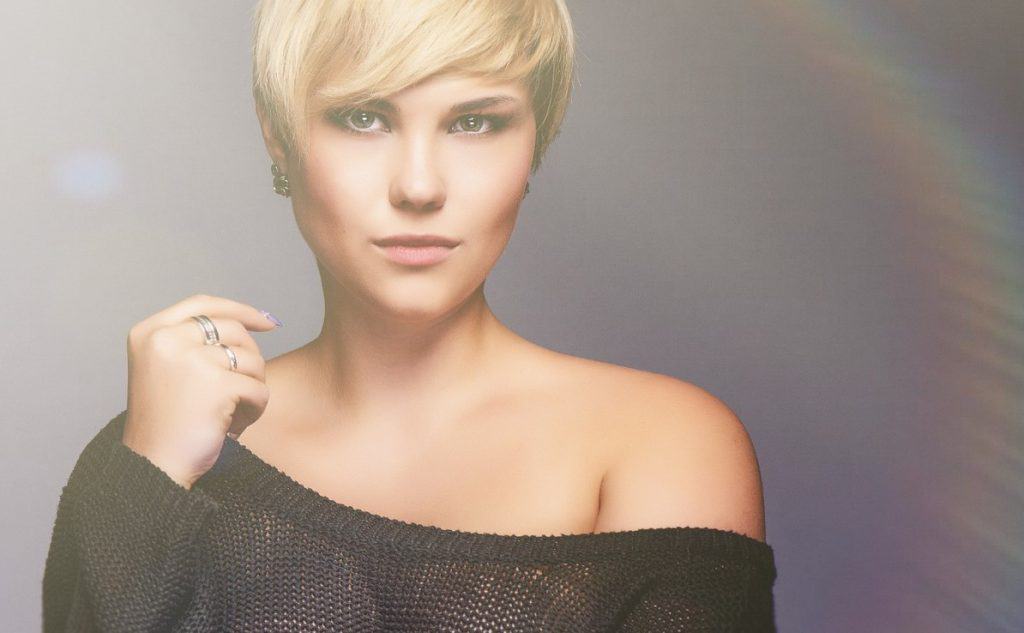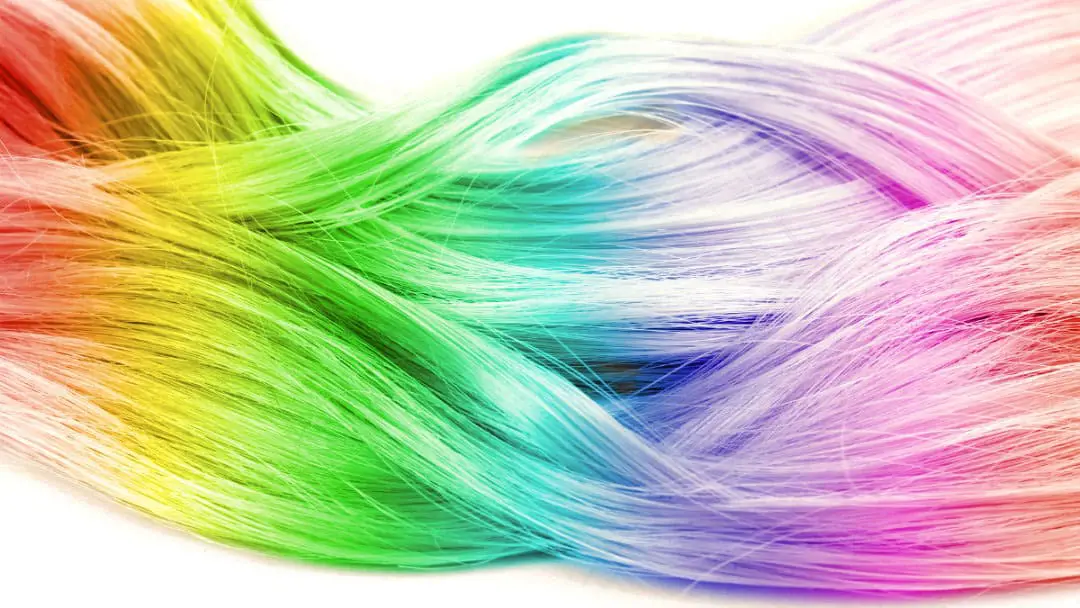Wanted to go icy blonde, and ended up with yellow hair? This is a very common problem when using bleach to lift color on dark hair. If you are after a platinum or ashy blonde, yellow and golden tones can totally spoil the effect. Sadly, depending on your original hair color it can be quite a challenge to fix them.
There are several ways to fix yellow hair after bleaching, even for stubborn brassy highlights that won’t go away nicely. Keep reading to learn how to prevent and fix yellow hair when lightening your hair.
Table of Contents
Why Do You Get Yellow Hair After Bleaching?
Most people can’t get platinum blonde hair just by bleaching or using high-lift dyes. This is because in order to reach platinum all pigments need to be removed from hair. Bleach removes pigments from hair, but at the same time it weakens it so reaching white from dark hair is often too risky.
As the bleaching process goes, hair turns several degrees of orange and, after a while, yellow, pale yellow and almost white. If your hair is naturally brown or black, the red and dark pigments in the hair are almost impossible to eliminate just using bleach, and you will end up with brassy, yellow, and gold tones in your hair, or with very damaged hair.
Depending on the porosity of your hair and the strength of the bleach used, this can be an overall yellowing or restricted to some areas of your head. It is important to be careful not to over-bleach your hair to try and get rid of the yellow because you may end up with a chemical haircut instead of glossy platinum locks. So it’s better to try alternatives to bleaching first, to see if you can fix the yellow without damaging your hair.
Your hair needs to be light enough for purple color depositing products to do anything. If your hair is not yet at the desired lightness level you may want to use a bleach bath to bring it just that bit lighter. Sometimes you need to bleach your hair to a lighter level and then apply a toner to darken it and remove any remaining yellow.
Even if you have your hair done at the hairdresser, yellow tones can appear after a few washes as the toner used to remove the unwanted yellow tones fades away. Purple shampoo and toning products are the best friends of any blonde that wants to keep their color bright and not yellow or brassy.
What Is a Toner And What Does It Do?
A toner, also called a gloss, is a product designed to remove unwanted colors in your hair, fill in areas with excess porosity and give your hair a glossy finish. This of it as a topcoat for your hair. After bleach lifts the color, a toner will fix unwanted brassy or red undertones and give you the perfect ashy or platinum color you were after. This is known as Two-process color.
A toner can be a permanent or semi-permanent color that has the right undertones to cancel the yellow tones in your hair. However, after bleach semi-permanent colors are preferable because they are less damaging to the hair.
Depending on which colors you want to cancel, you can use different toners, and here is when it gets fun: to cancel reddish tones you would go for a green color, whereas yellow tones require violet, and brassy tones are canceled by green and blue tones. However, be careful not to overdo it or you may end up with green hair! If you are trying to figure out how to fix yellow hair, a purple toner will be the solution. Here are some of our recommended toners.
A toner is not always necessary: if you have naturally blonde hair, a high-lift permanent hair color in a platinum shade may be all that you need, without the use of bleach. However, if you have dark hair, bleach will pre-lighten the hair to a degree that applying permanent hair color in a platinum/ashy shade will create the desired results. Semi-permanent toners generally wash out from hair after 2 to 8 weeks, depending on how often you wash your hair.
Can You Do At-Home Toning?
There are products sold in supermarkets and beauty stores that can work as a toner, as they deposit color on your hair which cancels the yellow and brassy tones. You can also use a permanent or semi-permanent hair dye but they sometimes have unexpected results as the undertones aren’t clear and you can end up overcorrecting with unwanted blue or green tones in your hair.
This can happen if you are learning how to fix orange hair, and you choose a toner that is too green for the amount of orange in your hair. I have written in more detail about how to tone your hair and which toner to use here.
Hair that has been bleached is more porous than usual, which means even a semi-permanent hair color (no ammonia hair colors) can take longer to wash out or even not wash out at all. For this reason, it is important to be aware of hair color levels and dye codes so you can pick a dye that fills the color in without adding unwanted overtones or making your hair too dark.

How to Fix Bleached Hair Without Damaging It
The first step towards fixing bleached hair is avoiding further damage. Bleached hair is very porous, and lacks protein. If you keep applying toners with developer you will eventually burn your bleached hair. If you want to fix yellow hair after bleaching, a conditioning mask with purple pigments (such as a mix of Manic Panic and a deep conditioning mask, left on your hair for half an hour) can be a non-damaging solution to try.
It is also important to choose the right toner for your hair level and desired blonde hair color. There are as many blonde hair dyes as there are blondes, and while you may think the problem is yellow in hair, maybe your actual issue is brassiness instead. To fix bleached hair you need to first make sure it has been lifted to the right level: You won’t get platinum blonde hair from hair that is a level 7 even if you use Wella t18 toner.
Try to look at your hair and decide first if it looks like a banana yellow, like the color inside the peel of a banana, or if it looks more like old gold or brass. If it’s the first, perfect, you need to use a purple toner or conditioner to fix it. If it’s the latter, you will need a blue-violet toner instead.
Learn more about choosing the right hair color level and the appropriate products, and get our expert advice on hair color levels here!
Hair Porosity Also Matters
Keep in mind porosity as well. When you try to fix bleached hair that has turned yellow or brassy you need to be careful not to add too much toner, or leaving it for too long. If you do, your hair may absorb too much toner and end up with a greyish or greenish cast.
This happens a lot with people who have very dark hair, and bleach it to light blonde or platinum. Keep an eye on the toner as it develops, it is better for your hair to have to tone twice than to have to wash with baking soda to remove excess toner.
Color Depositing Shampoos
A safer alternative to fix yellow tones after bleaching is using color-correcting shampoos and conditioners. For example, Redken Color Extend Blondage deposits variable amounts of purple in your hair depending on how long it was since you colored it, keeping brassiness away.
Other “Silver” shampoos and conditioners are designed to be used once a week or even every day, but pay close attention to the usage instructions unless you want to end up with bright purple hair.
This kind of shampoo have usually a very bright or purple color, but don’t worry, your hair will look platinum after using them because the amounts of dye deposited are just enough to cancel the unwanted brassy or yellow tones on bleached hair provided you use them correctly.
Other favorite shampoos for blondes are Bold Uniq and Clairol Shimmer Lights, which will also keep your blonde hair looking bright and silvery.
0


